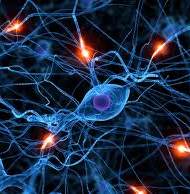New Mechanism for Controlling Calcium Influx in Cells is Identified
 An influx of too many calcium molecules has been known to overwhelm the brain cells, shutting down the channels through which these molecules enter the cells. The "stop" signal mechanism that human cells use to control this molecular traffic was unknown until recently.
An influx of too many calcium molecules has been known to overwhelm the brain cells, shutting down the channels through which these molecules enter the cells. The "stop" signal mechanism that human cells use to control this molecular traffic was unknown until recently.
Scientists at the Health System of the University of California at Davis reported in a recent issue of the journal Neuron that they have identified the mechanism. Their findings may help to better understand the molecular causes of the disruption of brain functioning that occurs in stroke and other neurological disorders.
"Too much calcium influx clearly is part of the neuronal dysfunction in Alzheimer's disease and causes the neuronal damage during and after a stroke," said Johannes W. Hell, the head of the research team and a professor of pharmacology at UC Davis. "It also contributes to chronic pain."
Hell's team identified the mechanism that stops the flow of calcium molecules (which are also known as ions) into the specialized brain cells called neurons.
According to Hell, each day millions of molecules of calcium enter and exit each of the 100 billion neurons of the human brain. This is accomplished through pore-like structures known as channels located in the outer surface or skin of each cell.
Researchers already knew that the flow of calcium ions into brain cells is responsible for generating the electrical impulses necessary to stimulate actions such as the movement of muscles in our limbs and the creation of new memories in the brain.
The movement of calcium ions also plays a role in gene expression and affects the flexibility of the synapses that transmit electrical signals from one cell to another.
The team discovered o-actinin stabilizes the type of ion channels that constitute a major source of calcium ion influx into brain cells. The researchers also uncovered the significance of the calcium-binding messenger protein calmodulin, which is the brain's cell sensor for calcium ion.
This was not Hell's first publication regarding neurological mechanisms.
In 2001, Hell and some of his colleagues published findings from a study they conducted that proved relevant to understanding the biological mechanisms that occur during the body's "fight-or-flight" response.
Posted in New Mechanism for Controlling Calcium Influx in Cells is Identified
Ask a Question Or Join a Discussion


